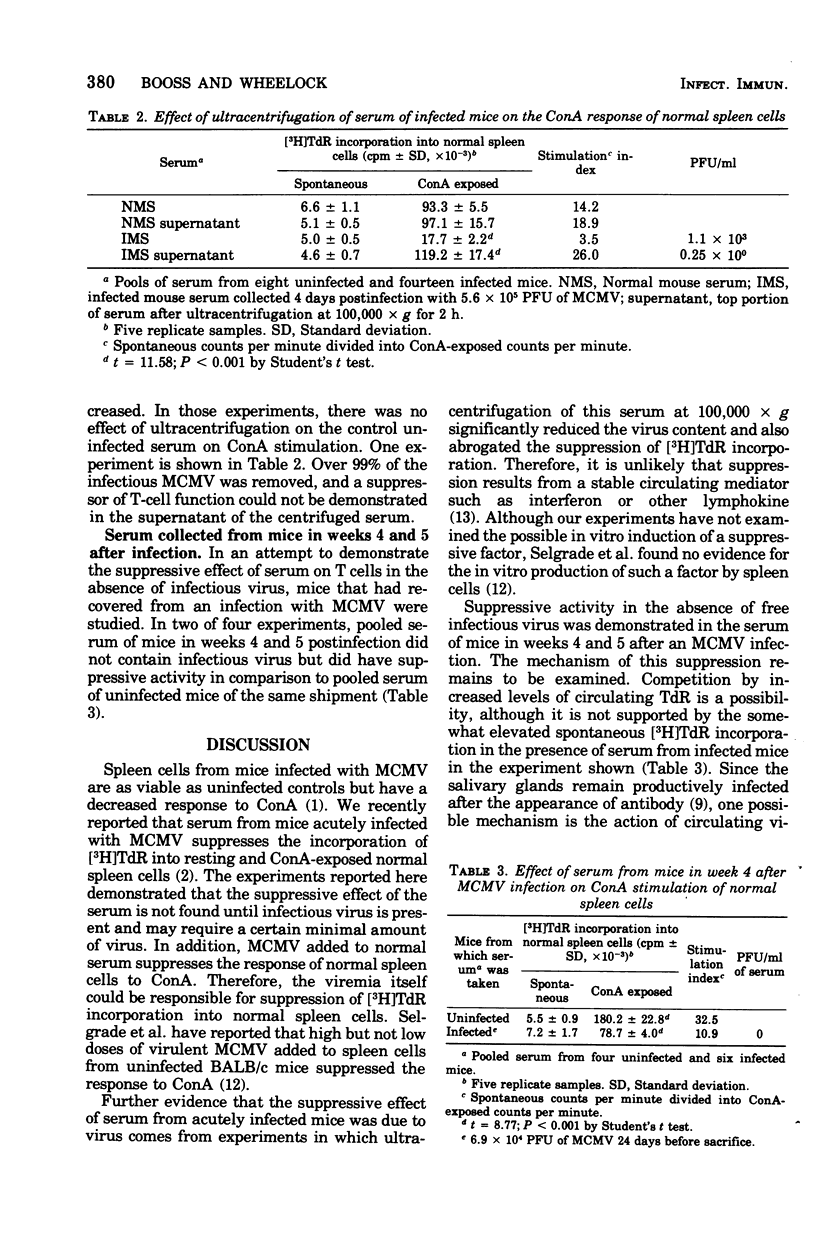Abstract
The suppression of T-cell deoxyribonucleic acid (DNA) synthesis by serum from mice acutely with murine cytomegalovirus (MCMV) was investigated. Spleen cells from uninfected mice were exposed to concanavalin A in the presence of serum taken from mice at various times after infection with MCMV. The capacity of the serum to suppress DNA synthesis first appeared at day 3 postinfection and was associated with free infectious virus. Addition of MCMV to serum from uninfected mice also suppressed DNA synthesis. Ultracentrifugation of serum from mice acutely infected with MCMV removed most of the virus and aborgated the inhibition of DNA synthesis. However, in two of four experiments, serum from mice in weeks 4 and 5 postinfection did not contain infectious MCMB but did suppress. Therefore, it appears that MCMV itself can suppress DNA synthesis of T cells; however, this may not be the exclusive mechanism of suppression exerted by serum from MCMB-infected mice.
Full text
PDF



Selected References
These references are in PubMed. This may not be the complete list of references from this article.
- Booss J., Wheelock E. F. Correlation of survival from murine cytomegalovirus infection with spleen cell responsiveness to Concanavallin A. Proc Soc Exp Biol Med. 1975 Jun;149(2):443–445. doi: 10.3181/00379727-149-38824. [DOI] [PubMed] [Google Scholar]
- Booss J., Wheelock E. F. Progressive inhibition of T-cell function preceding clinical signs of cytomegalovirus infection in mice. J Infect Dis. 1977 Mar;135(3):478–481. doi: 10.1093/infdis/135.3.478. [DOI] [PubMed] [Google Scholar]
- Fujibayashi T., Hooks J. J., Notkins A. L. Production of interferon by immune lymphocytes exposed to herpes simplex virus-antibody complexes. J Immunol. 1975 Nov;115(5):1191–1193. [PubMed] [Google Scholar]
- Gorczynski R., Kontiainen S., Mitchison N. A., Tigelaar R. E. Antigen--antibody complexes as blocking factors on the T lymphocyte surface. Soc Gen Physiol Ser. 1974;29:143–154. [PubMed] [Google Scholar]
- Gresser I., Bandu M. T., Tovey M., Bodo G., Paucker K., Stewart W., 2nd Interferon and cell division. VII. Inhibitory effect of highly purified interferon preparations on the multiplication of leukemia L 1210 cells. Proc Soc Exp Biol Med. 1973 Jan;142(1):7–10. doi: 10.3181/00379727-142-36945. [DOI] [PubMed] [Google Scholar]
- Howard R. J., Miller J., Najarian J. S. Cytomegalovirus-induced immune suppression. II. Cell-mediated immunity. Clin Exp Immunol. 1974 Sep;18(1):119–126. [PMC free article] [PubMed] [Google Scholar]
- Lee J. C., Sigel M. M. A differential effect of IgM and IgG antibodies on the blastogenic response of lymphocytes to rubella virus. Cell Immunol. 1974 Jul;13(1):22–31. doi: 10.1016/0008-8749(74)90223-8. [DOI] [PubMed] [Google Scholar]
- MEDEARIS D. N., Jr MOUSE CYTOMEGALOVIRUS INFECTION. II. OBSERVATIONS DURING PROLONGED INFECTIONS. Am J Hyg. 1964 Jul;80:103–112. [PubMed] [Google Scholar]
- Mirchamsy H., Rapp F. A new overlay for plaquing animal viruses. Proc Soc Exp Biol Med. 1968 Oct;129(1):13–17. doi: 10.3181/00379727-129-33237. [DOI] [PubMed] [Google Scholar]
- Moon H. M., Sapienza V. J., Carp R. I., Kim K. S. DNA synthesis in mouse embryo fibroblast cells infected with murine cytomegalovirus. Virology. 1976 Dec;75(2):376–383. doi: 10.1016/0042-6822(76)90036-2. [DOI] [PubMed] [Google Scholar]
- Selgrade M. K., Ahmed A., Sell K. W., Gershwin M. E., Steinberg A. D. Effect of murine cytomegalovirus on the in vitro responses of T and B cells to mitogens. J Immunol. 1976 May;116(5):1459–1465. [PubMed] [Google Scholar]
- Waksman B. H., Namba Y. On soluble mediators of immunologic regulation. Cell Immunol. 1976 Jan;21(1):161–176. doi: 10.1016/0008-8749(76)90337-3. [DOI] [PubMed] [Google Scholar]


